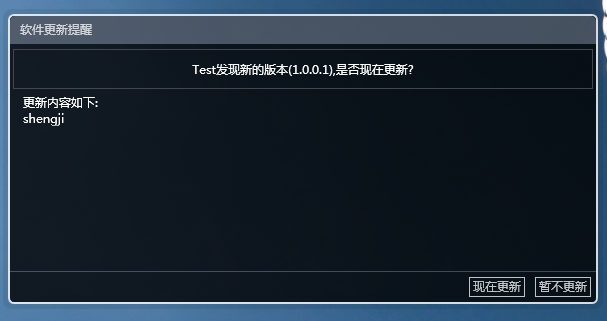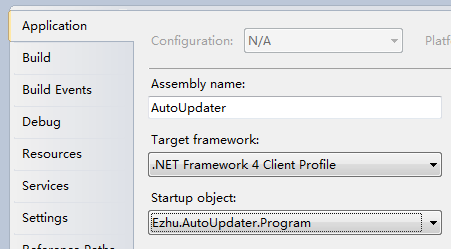前几天介绍了WPF进行自定义窗口的开发,关注的朋友还挺多,超出本人意料,呵呵,那么我就再接再励,在上篇的基础上,讲述一下软件自动升级组件的开发原理,大家时间宝贵,不想搞太长的篇幅,所以尽可能拣重要的说说,附件中有源码,没时间朋友直接下载吧,希望有需要的朋友能用的上,有时间的朋友还是跟着本文一起,体验一下开发的过程吧,因为这个组件做的挺赶,问题估计不少,大家发现问题欢迎踊跃留言,本文只做抛砖引玉的作用...
废话不说,开始!
软件发布后,自动升级往往是一项必备的功能,本篇博客的目标就是用WPF打造一个自动升级组件。先看效果:

升级提醒界面

升级过程界面

升级完成界面
升级界面不是本文的内容,具体见我的上一篇博客
其实升级的过程很简单,大致如下:
检测服务器上的版本号—>比较本地程序的版本号和服务器上的版本号—>如果不相同则下载升级的压缩包—>下载完成后解压升级包—>解压后的文件覆盖到应用程序文件目录—>升级完成
有两点需要注意:
- 因为升级的过程就是用新文件覆盖旧文件的过程,所以要防止老文件被占用后无法覆盖的情况,因而升级之前应该关闭运用程序。
- 升级程序本身也可能需要升级,而升级程序启动后如问题1所说,就不可能被覆盖了,因而应该想办法避免这种情况。
有了上面的分析,下面我们就来具体实现之。
首先新建一个WPF Application项目,命名为AutoUpdater,因为升级程序需要能够单独执行,必须编译成exe文件,所以不能是类库项目。
接下来新建一个类Updater.cs来处理检测的过程。
服务器上的版本信息我们存储到一个XML文件中,文件格式定义如下:
 View Code
View Code
<?xml version="1.0" encoding="utf-8"?> <UpdateInfo> <AppName>Test</AppName> <AppVersion>1.0.0.1</AppVersion> <RequiredMinVersion>1.0.0.0</RequiredMinVersion> <Desc>shengji</Desc> </UpdateInfo>
然后定义一个实体类对应XML定义的升级信息,如下:
 View Code
View Code
public class UpdateInfo { public string AppName { get; set; } /// <summary> /// 应用程序版本 /// </summary> public Version AppVersion { get; set; } /// <summary> /// 升级需要的最低版本 /// </summary> public Version RequiredMinVersion { get; set; } public Guid MD5 { get; set; } private string _desc; /// <summary> /// 更新描述 /// </summary> public string Desc { get { return _desc; } set { _desc = string.Join(Environment.NewLine, value.Split(new char[] { '\r', '\n' }, StringSplitOptions.RemoveEmptyEntries)); } } }
检测的详细步骤应该如下:
- 异步下载update.xml到本地
- 分析xml文件信息,存储到自定义的类UpdateInfo中
- 判断升级需要的最低版本号,如果满足,启动升级程序。这里就碰到了上面提到的问题,文件被占用的问题。因为如果直接启动AutoUpdater.exe,升级包中的AutoUpdater.exe是无法覆盖这个文件的,所以采取的办法是将AutoUpdater.exe拷贝到缓存文件夹中,然后启动缓存文件夹中的AutoUpdater.exe文件来完成升级的过程。
具体代码如下,第一个方法CheckUpdateStatus()完成1、2两个步骤,第二个方法StartUpdate(UpdateInfo updateInfo)完成步骤3:
 View Code
View Code
public static void CheckUpdateStatus() { System.Threading.ThreadPool.QueueUserWorkItem((s) => { string url = Constants.RemoteUrl + Updater.Instance.CallExeName + "/update.xml"; var client = new System.Net.WebClient(); client.DownloadDataCompleted += (x, y) => { try { MemoryStream stream = new MemoryStream(y.Result); XDocument xDoc = XDocument.Load(stream); UpdateInfo updateInfo = new UpdateInfo(); XElement root = xDoc.Element("UpdateInfo"); updateInfo.AppName = root.Element("AppName").Value; updateInfo.AppVersion = root.Element("AppVersion") == null || string.IsNullOrEmpty(root.Element("AppVersion").Value) ? null : new Version(root.Element("AppVersion").Value); updateInfo.RequiredMinVersion = root.Element("RequiredMinVersion") == null || string.IsNullOrEmpty(root.Element("RequiredMinVersion").Value) ? null : new Version(root.Element("RequiredMinVersion").Value); updateInfo.Desc = root.Element("Desc").Value; updateInfo.MD5 = Guid.NewGuid(); stream.Close(); Updater.Instance.StartUpdate(updateInfo); } catch { } }; client.DownloadDataAsync(new Uri(url)); }); } public void StartUpdate(UpdateInfo updateInfo) { if (updateInfo.RequiredMinVersion != null && Updater.Instance.CurrentVersion < updateInfo.RequiredMinVersion) { //当前版本比需要的版本小,不更新 return; } if (Updater.Instance.CurrentVersion >= updateInfo.AppVersion) { //当前版本是最新的,不更新 return; } //更新程序复制到缓存文件夹 string appDir = System.IO.Path.Combine(System.Reflection.Assembly.GetEntryAssembly().Location.Substring(0, System.Reflection.Assembly.GetEntryAssembly().Location.LastIndexOf(System.IO.Path.DirectorySeparatorChar))); string updateFileDir = System.IO.Path.Combine(System.IO.Path.Combine(appDir.Substring(0, appDir.LastIndexOf(System.IO.Path.DirectorySeparatorChar))), "Update"); if (!Directory.Exists(updateFileDir)) { Directory.CreateDirectory(updateFileDir); } updateFileDir = System.IO.Path.Combine(updateFileDir, updateInfo.MD5.ToString()); if (!Directory.Exists(updateFileDir)) { Directory.CreateDirectory(updateFileDir); } string exePath = System.IO.Path.Combine(updateFileDir, "AutoUpdater.exe"); File.Copy(System.IO.Path.Combine(appDir, "AutoUpdater.exe"), exePath, true); var info = new System.Diagnostics.ProcessStartInfo(exePath); info.UseShellExecute = true; info.WorkingDirectory = exePath.Substring(0, exePath.LastIndexOf(System.IO.Path.DirectorySeparatorChar)); updateInfo.Desc = updateInfo.Desc; info.Arguments = "update " + Convert.ToBase64String(System.Text.Encoding.UTF8.GetBytes(CallExeName)) + " " + Convert.ToBase64String(System.Text.Encoding.UTF8.GetBytes(updateFileDir)) + " " + Convert.ToBase64String(System.Text.Encoding.UTF8.GetBytes(appDir)) + " " + Convert.ToBase64String(System.Text.Encoding.UTF8.GetBytes(updateInfo.AppName)) + " " + Convert.ToBase64String(System.Text.Encoding.UTF8.GetBytes(updateInfo.AppVersion.ToString())) + " " + (string.IsNullOrEmpty(updateInfo.Desc) ? "" : Convert.ToBase64String(System.Text.Encoding.UTF8.GetBytes(updateInfo.Desc))); System.Diagnostics.Process.Start(info); }
在方法StartUpdate的最后,启动Autoupdate.exe的代码中,需要将升级信息当做参数传递过去,各参数间用空格分隔,考虑到信息本身(如AppName或Desc中)可能含有空格,所以传递前将信息进行Base64编码。
接下来打开Program.cs文件(没有可以自己创建一个,然后在项目属性中修改启动对象,如下图),

在Main函数中接收传递过来的参数。代码如下:
 View Code
View Code
static void Main(string[] args) { if (args.Length == 0) { return; } else if (args[0] == "update") { try { string callExeName = args[1]; string updateFileDir = args[2]; string appDir = args[3]; string appName = args[4]; string appVersion = args[5]; string desc = args[6]; Ezhu.AutoUpdater.App app = new Ezhu.AutoUpdater.App(); UI.DownFileProcess downUI = new UI.DownFileProcess(callExeName, updateFileDir, appDir, appName, appVersion, desc) { WindowStartupLocation = WindowStartupLocation.CenterScreen }; app.Run(downUI); } catch (Exception ex) { MessageBox.Show(ex.Message); } }
参数接收成功后,打开下载界面,显示升级的主要内容,如果用户点击升级按钮,则开始下载升级包。
步骤应该如下:
- 关闭应用程序进程
- 下载升级包到缓存文件夹
- 解压升级包到缓存文件夹
- 从缓存文件夹复制解压后的文件和文件夹到运用程序目录
- 提醒用户升级成功
具体代码如下:
 View Code
View Code
public partial class DownFileProcess : WindowBase { private string updateFileDir;//更新文件存放的文件夹 private string callExeName; private string appDir; private string appName; private string appVersion; private string desc; public DownFileProcess(string callExeName, string updateFileDir, string appDir, string appName, string appVersion, string desc) { InitializeComponent(); this.Loaded += (sl, el) => { YesButton.Content = "现在更新"; NoButton.Content = "暂不更新"; this.YesButton.Click += (sender, e) => { Process[] processes = Process.GetProcessesByName(this.callExeName); if (processes.Length > 0) { foreach (var p in processes) { p.Kill(); } } DownloadUpdateFile(); }; this.NoButton.Click += (sender, e) => { this.Close(); }; this.txtProcess.Text = this.appName + "发现新的版本(" + this.appVersion + "),是否现在更新?"; txtDes.Text = this.desc; }; this.callExeName = System.Text.Encoding.UTF8.GetString(Convert.FromBase64String(callExeName)); this.updateFileDir = System.Text.Encoding.UTF8.GetString(Convert.FromBase64String(updateFileDir)); this.appDir = System.Text.Encoding.UTF8.GetString(Convert.FromBase64String(appDir)); this.appName = System.Text.Encoding.UTF8.GetString(Convert.FromBase64String(appName)); this.appVersion = System.Text.Encoding.UTF8.GetString(Convert.FromBase64String(appVersion)); string sDesc = System.Text.Encoding.UTF8.GetString(Convert.FromBase64String(desc)); if (sDesc.ToLower().Equals("null")) { this.desc = ""; } else { this.desc = "更新内容如下:\r\n" + sDesc; } } public void DownloadUpdateFile() { string url = Constants.RemoteUrl + callExeName + "/update.zip"; var client = new System.Net.WebClient(); client.DownloadProgressChanged += (sender, e) => { UpdateProcess(e.BytesReceived, e.TotalBytesToReceive); }; client.DownloadDataCompleted += (sender, e) => { string zipFilePath = System.IO.Path.Combine(updateFileDir, "update.zip"); byte[] data = e.Result; BinaryWriter writer = new BinaryWriter(new FileStream(zipFilePath, FileMode.OpenOrCreate)); writer.Write(data); writer.Flush(); writer.Close(); System.Threading.ThreadPool.QueueUserWorkItem((s) => { Action f = () => { txtProcess.Text = "开始更新程序..."; }; this.Dispatcher.Invoke(f); string tempDir = System.IO.Path.Combine(updateFileDir, "temp"); if (!Directory.Exists(tempDir)) { Directory.CreateDirectory(tempDir); } UnZipFile(zipFilePath, tempDir); //移动文件 //App if(Directory.Exists(System.IO.Path.Combine(tempDir,"App"))) { CopyDirectory(System.IO.Path.Combine(tempDir,"App"),appDir); } f = () => { txtProcess.Text = "更新完成!"; try { //清空缓存文件夹 string rootUpdateDir = updateFileDir.Substring(0, updateFileDir.LastIndexOf(System.IO.Path.DirectorySeparatorChar)); foreach (string p in System.IO.Directory.EnumerateDirectories(rootUpdateDir)) { if (!p.ToLower().Equals(updateFileDir.ToLower())) { System.IO.Directory.Delete(p, true); } } } catch (Exception ex) { //MessageBox.Show(ex.Message); } }; this.Dispatcher.Invoke(f); try { f = () => { AlertWin alert = new AlertWin("更新完成,是否现在启动软件?") { WindowStartupLocation = WindowStartupLocation.CenterOwner, Owner = this }; alert.Title = "更新完成"; alert.Loaded += (ss, ee) => { alert.YesButton.Width = 40; alert.NoButton.Width = 40; }; alert.Width=300; alert.Height = 200; alert.ShowDialog(); if (alert.YesBtnSelected) { //启动软件 string exePath = System.IO.Path.Combine(appDir, callExeName + ".exe"); var info = new System.Diagnostics.ProcessStartInfo(exePath); info.UseShellExecute = true; info.WorkingDirectory = appDir;// exePath.Substring(0, exePath.LastIndexOf(System.IO.Path.DirectorySeparatorChar)); System.Diagnostics.Process.Start(info); } else { } this.Close(); }; this.Dispatcher.Invoke(f); } catch (Exception ex) { //MessageBox.Show(ex.Message); } }); }; client.DownloadDataAsync(new Uri(url)); } private static void UnZipFile(string zipFilePath, string targetDir) { ICCEmbedded.SharpZipLib.Zip.FastZipEvents evt = new ICCEmbedded.SharpZipLib.Zip.FastZipEvents(); ICCEmbedded.SharpZipLib.Zip.FastZip fz = new ICCEmbedded.SharpZipLib.Zip.FastZip(evt); fz.ExtractZip(zipFilePath, targetDir, ""); } public void UpdateProcess(long current, long total) { string status = (int)((float)current * 100 / (float)total) + "%"; this.txtProcess.Text = status; rectProcess.Width = ((float)current / (float)total) * bProcess.ActualWidth; } public void CopyDirectory(string sourceDirName, string destDirName) { try { if (!Directory.Exists(destDirName)) { Directory.CreateDirectory(destDirName); File.SetAttributes(destDirName, File.GetAttributes(sourceDirName)); } if (destDirName[destDirName.Length - 1] != Path.DirectorySeparatorChar) destDirName = destDirName + Path.DirectorySeparatorChar; string[] files = Directory.GetFiles(sourceDirName); foreach (string file in files) { File.Copy(file, destDirName + Path.GetFileName(file), true); File.SetAttributes(destDirName + Path.GetFileName(file), FileAttributes.Normal); } string[] dirs = Directory.GetDirectories(sourceDirName); foreach (string dir in dirs) { CopyDirectory(dir, destDirName + Path.GetFileName(dir)); } } catch (Exception ex) { throw new Exception("复制文件错误"); } } }
注:
- 压缩解压用到开源库SharpZipLib,官网: http://www.icsharpcode.net/OpenSource/SharpZipLib/Download.aspx
- 服务器上升级包的目录层次应该如下(假如要升级的运用程序为Test.exe):
Test(与exe的名字相同)
----update.xml
----update.zip
update.zip包用如下方式生成:
新建一个目录APP,将所用升级的文件拷贝到APP目录下,然后压缩APP文件夹为update.zip文件
- 升级服务器的路径配置写到Constants.cs类中。
- 使用方法如下,在要升级的运用程序项目的Main函数中,加上一行语句:
- Ezhu.AutoUpdater.Updater.CheckUpdateStatus();
到此,一款简单的自动升级组件就完成了!
前几天代码链接加到上一篇博客的附件上了,请需要的朋友重新下载,感谢yeyong这位朋友的指正!




